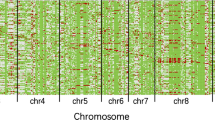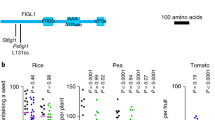Abstract
A phenomenon, loss of heterozygosity (LOH), was discovered in hybrid plants involving a selected plant (named AMR) of the Chinese rice cultivar ‘ZhongxinNo. 1’ as one parent. In these hybrids and some of their progenies, somatic variations were manifested by molecular genotypes and/or morphological phenotypes in vegetative parts of the same plant. Random amplified polymorphic DNA (RAPD) markers for the parents have been followed through the F3 generation. RAPD markers were uniformly present or absent in all plants within some or all F2 panicle rows derived from F1 hybrids involving AMR. In contrast, RAPD markers segregated in the Mendelian manner for dominant markers in panicle rows derived from control hybrids. Certain F2 panicle rows from F1hybrids involving the special rice became fixed for all assayed RAPD markers. Genotype fixation was confirmed by molecular assays and field observations of the F3 progenies. We propose a new biological mechanism, called ‘assortment mitosis,’ as being responsible for the observed phenomenon. The use of this mechanism in plant hybrids allows the development of uniform progenies as early as the F2 generation. Therefore, the time required to obtain fixed non-parental type progenies for subsequent performance trials can be drastically shortened. Utilizing this mechanism in plant breeding represents a new approach and requires the modification of conventional plant breeding procedures.
Similar content being viewed by others
References
Barclay, J.R., 1975. High frequencies of haploid production in wheat (Triticum aestivum) by chromosome elimination. Nature 256: 410–411.
Chen, J., 1992. A collection of papers on breeding of apomictic rice. China Science and Technology Press, Beijing, 118 pp.
Chigira, M., S. Arita & H. Watanabe, 1993. Loss of heterozygosity: origin or result of carcinogenesis? (Review) Int. J. Oncology 2: 931–935.
Cote, G.B. & J. Gyftodimou, 1991. Twinning and mitotic crossingover: some possibilitiesand their implications. Am J Hum Genet 49: 120–130.
Faruqi, S.A., R.C. Miller & J.S. Noumoff, 1994. Somatic pairing: an alternative for the development of cancer and other hereditary diseases. Cytologia 59: 439–444.
Fedoroff, N.V., 1983. Controlling elements in maize. In: J.A. Shapiro (Ed.), Mobile Genetic Elements, pp. 1–63. Academic Press, New York.
Fehr, W.R., 1987. Principles of Cultivar Development. Vol. 1. Theory and Technique. Macmillan, New York.
Hanna, W.W. & E.C. Bashaw, 1987. Apomixis: its identification and use in plant breeding. Crop Sci 27: 1136–1139.
Hunt, R.H., 1987. Somatic recombination events in mosquitoes: three different karyotypes observed in the ovarian nurse cells of individual Anopheles gambiae s. str. J Hered 78: 41–43.
Kasha, K.J. & K.N. Kao, 1970. High frequency haploid production in barley (H. vulgare L.). Nature (Lond.) 225: 874–875.
Knudson, A.G. Jr., 1985. Hereditary cancer, oncogenes and antioncogenes. Cancer Res 45: 1437–1443.
Li, Z., J.G. Wu, Y. Liu, H.L. Liu & W.K. Heneen, 1998. Production and cytogeneticsof the intergeneric hybrids Brassica juncea × Orychophragmus violaceus and B. carinata × O. violaceus. Theor Appl Genet 96: 251–265.
McClintock, B., 1950. The origin and behavior of mutable loci in maize. Proc Natl Acad Sci USA 36: 344–355.
McClintock, B., 1951. Chromosome organization and genic expression. Cold Spring Harbor Symp Quant Biol 16: 13–47.
Newton, A.C., 1989. Somatic recombination in Rhynchosporium secalis. Plant Pathology 38: 71–74.
Nitsch, J.P. & C. Nitsch, 1969. Haploid plants from pollen grains. Science 163: 85–87.
Schwarzacher, T., J.S. Heslop-Harrison & K. Anamthawat-Jonsson, 1992. Parentalgenome separation in reconstructions of somatic and premeiotic metaphases of Hordeum vulgare × H. bulbosum. J. Cell Sci 101: 13–24.
Shi, G., P. Ni, J. Song, X. Mu & T. Liang, 1996. A cytoembryological study on rice 84–15, a rice line presumed to be apomictic. Acta Agronomica Sinica 22: 657–660.
Sunderland, N., 1970. Pollen plants and their significance. New Scient 47: 142–144.
Sybenga, J., 2000. Somatic segregation in rice. Genome 43: 720–722.
Vogelstein, B., E.R. Fearon, S.E. Kern, S.R. Hamilton, A.C. Preisinger, Y. Nakamura & R. White, 1989. Allotype of colorectal carinoma. Science 244: 207–211.
Wang, R.R.-C., X.-M. Li & N.J. Chatterton, 1999a. Loss of heterozygosity and accelerated genotype fixation in rice hybrids. Genome 42: 789–796.
Wang, R.R.-C., X.-M. Li, S.R. Larson & N.J. Chatterton, 1999b. Mapping of eight RAPD markers affected by loss of heterozygosity in rice. Rice Technology Quarterly 40: 16–17.
Wen, F., F.L. Barnett & G.H. Liang, 1989. Somatic pairing and separation of chromosomes in root-tip cells of regenerated sorghum plants. J Hered 80: 159–160.
Williams, J.G.K., M.K. Hanafey, J.A. Rafalski & S.V. Tingey, 1991. Genetic analysis using random amplified polymorphic DNA markers. Methods in Enzymology 218: 704–740.
Williams, J.G.K., A.R. Kubelik, K.J. Livak, J.A. Rafalski & S.V. Tingey, 1990. DNA polymorphisms amplified by arbitrary primers are useful as genetic markers. Nucleic Acid Res 18: 6531–6535.
Wu, X.-J., X-D. Wang, K-D. Zhou & L-H. Zhu. 1999. A nonsegregating F2 populationderived from the cross of triploid × diploid in rice. Acta Botanica Sinica 41: 1067–1071.
Author information
Authors and Affiliations
Rights and permissions
About this article
Cite this article
Wang, R.RC., Li, X. & Chatterton, N.J. A proposed mechanism for loss of heterozygosity in rice hybrids. Euphytica 118, 119–126 (2001). https://doi.org/10.1023/A:1004010517197
Issue Date:
DOI: https://doi.org/10.1023/A:1004010517197




